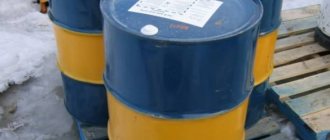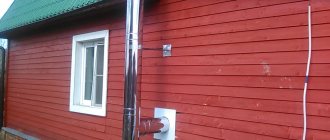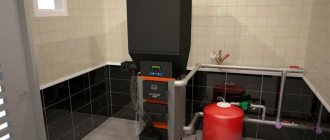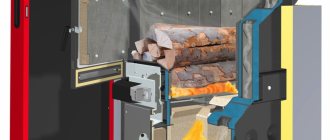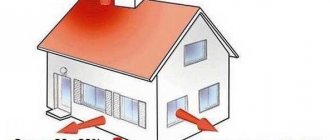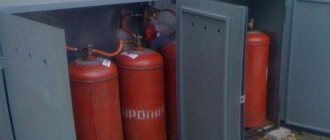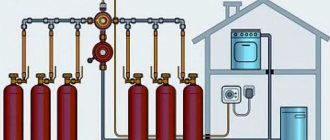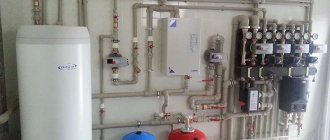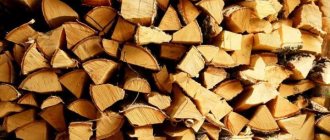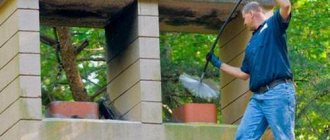Features of the operation of modern solid fuel boilers
Solid fuel boilers of the modern generation are equipped with a pressurization system and an automatic control unit.
Electronics controls the temperature of the coolant using a sensor installed in the heat exchanger. Depending on the temperature conditions, the automation gives commands to turn on and off the blower, which supplies air to the combustion chamber and facilitates the effective removal of combustion products through the chimney. This regulates the intensity of the fuel combustion process depending on the temperature of the coolant. Thus, the user takes the minimum necessary participation in the operation of the equipment. His concern about how to fire a TT boiler comes down to adding fuel at a certain frequency. After this, the boiler switches to intensive combustion mode. As the temperature rises, the combustion intensity weakens, and when the temperature reaches its maximum, the boiler goes into smoldering mode. After the coolant temperature drops below the set value, the boost is turned on again.
Timely loading of fuel into the TT boiler is the main task of the user, which cannot be automated. The number and frequency of fillings is determined based on the boiler power and the required temperature conditions. If you miss the start date, the boiler will only be able to operate in smoldering mode for a limited time, after which it stops.
It is of great importance how to heat a solid fuel boiler. Today the following types of fuel can be used for this purpose:
To achieve maximum efficiency, you need to know how to effectively heat a solid fuel boiler with different types of fuel.
How to properly heat a boiler with peat briquettes
How to properly heat with peat briquettes? A popular question among users. To ignite the fuel, a temperature of 150 °C is required. In order to achieve it, you need to use a burning chip or a special lighter fluid. To select a comfortable temperature in the room, it will take only a day.
Light the peat, wait until it burns well and the temperature in the room becomes optimal.
After this, insert a few more peat briquettes, turn off the blower, and set the damper on the pipe to the smallest distance. In this mode, heating will remain for a long time. Briquettes can be broken into smaller pieces and fired into the boiler.
Peat was widely used during the Soviet era, until the time came for complete gasification. Gradually, this type of fuel almost completely disappeared. It is currently gaining popularity again, perhaps due to rising prices for natural gas and coal.
The conversion of coal boiler houses to peat in some regions of Russia is carried out under the leadership of government agencies. There are users who privately want to change an already installed coal boiler.
Which fuel to choose
When deciding what is the best way to heat a solid fuel boiler, it is necessary to take into account the recommendations of the equipment manufacturer. Certain boiler models can be designed for specific fuels. However, many modern units are capable of operating on all of the listed types of fuel.
When choosing how to heat a long-burning solid fuel boiler conveniently and profitably, you need to take into account the burn rate of the fuel, which can vary greatly for different types. The frequency of necessary bookmarks and the ease of use of the unit depend on this.
Dry firewood is the fuel that burns out the fastest. Therefore, today fuel briquettes, which are made from dry sawdust, are often used for TT boilers. Such briquettes, which are also called “Eurowood”, burn out 1.5-2 times slower than ordinary dry firewood. Peat fuel briquettes are also produced. However, they are characterized by high ash content, and therefore peat briquettes are used mainly for water-heating boilers with grate fireboxes. Coal burns the slowest. Some coal boilers, using high-quality anthracite and additionally equipped with a heat accumulator, are able to operate on one load for up to two days even in severe frost.
Pellets burn almost as long as coal, and at the same time provide a high level of efficiency. However, it is also the most expensive type of solid fuel for modern boilers. The main advantage of pellets is that they allow you to automate the operation of the boiler as much as possible, bringing it closer in convenience to the level of a gas unit. However, they cannot be used in a conventional TT boiler - it must be equipped with a special burner and a combustion door of a special design.
Features of wood burning
To ensure high-quality heating, you need to know how to heat a solid fuel boiler with wood efficiently and economically. For kindling, chips are laid down, on top of which you need to place 3-5 firewood with a diameter of up to 15 cm. It is recommended to lay crumpled paper between the chips so that the wood flares up faster.
After the first fire has ignited, the firebox is filled with large firewood. To achieve the most complete and efficient burning of wood, you can place 1-2 large logs in the firebox at intervals of 30-40 minutes. In addition, this method will help reduce firewood consumption.
When the firebox is completely filled with large firewood, an ordinary modern solid fuel boiler is capable of maintaining fairly intense combustion for 3-4 hours. Long-burning boilers operate on one burner even longer. It is generally not recommended to burn such models with small wood, which does not burn completely due to increased gas emission. The optimal size of logs in diameter is 15-30 cm.
If you figure out how to properly heat a TT boiler, then the choice of firewood is of great importance. Wood moisture content should not be higher than 20%, otherwise the efficiency of the equipment will be lost. In some cases, to increase the burning time, damp wood is specially placed in the firebox, which takes longer to burn. However, it must be taken into account that this leads to increased release of tar, which settles on the walls of the firebox and on the chimney, and this causes deterioration in draft. As a result, the boiler has to be cleaned more often. In order for firewood to have an optimal level of humidity, it must be dried under a canopy for approximately 1.5-2 years before use.
Installation of a boiler using pellets and wood
Installation of equipment is carried out taking into account fire safety standards. They are set out in the relevant chapters of SNiP.
Premises requirements
The heater is prohibited from being placed in living rooms.
A wood-pellet boiler requires a special room.
A special room is allocated with the following parameters:
- separate entrance with a width of 0.8 m;
- ceiling height from 2.5 (m);
- volume from 15 cubic meters m + 0.2 for each kW of device power, but not less than 7 (cubic m);
- area from 7 sq. m;
- fire resistance limit of 0.75 hours at walls, partitions and ceilings separating the boiler room from other rooms;
- supply and exhaust ventilation performance corresponding to the power of the heat generator.
The combi boiler must not be installed in the basement.
Boiler room organization
The base for the equipment is selected taking into account its weight (kg):
- up to 200 – cement-sand screed;
- 200-300 – reinforced concrete;
- over 300 – separate foundation.
The distance between the device and the walls is maintained (m):
- from the firebox side – 2;
- on the sides and back - 1.
There must be a distance between the boiler and the wall.
It is allowed to reduce the distance to 0.8 (m) (except for the front part) if the structures are plastered with a fire-resistant compound, for example, vermiculite, 25 mm thick.
The floor within a radius of 1.2 m from the center of the combustion chamber door is protected with a 1.2 mm steel flooring on a thermal insulating substrate made of basalt cardboard.
Fuel storage standards
It is allowed to keep a daily supply of fuel in the boiler room. With an average consumption of pellets and firewood of 2-4 kg/hour, its weight will be 50-100 (kg).
The rest of the fuel is stored in another room at a distance of at least 1 m and no more than 20 (m) from the boiler.
The warehouse must be dry and well ventilated. Flammable materials must not be stored in it or in the furnace room.
Wood dust can explode in high concentrations. To avoid this, take the following measures:
- wipe surfaces regularly, paying special attention to the auger feeder and the area around it;
- ground all non-current-carrying metal parts of the electric drive.
Choosing a smoke removal system
The exhaust pipe must have:
- round or oval cross-section;
- resistance to high temperatures and acids;
- thermal insulation coating;
- vertical arrangement;
- height from 5 m relative to the boiler firebox.
The most popular are prefabricated “sandwich” chimneys made of stainless steel in a shell of mineral wool. The kit includes everything you need: pipes, condensate collectors, grooves, clamps, brackets for mounting to the wall, etc.
The exhaust pipe must be round.
Modern economical boilers produce exhaust with a relatively low temperature - less than +200°C.
As a result, a large amount of acidic condensate forms on the walls of the chimney. If the pipe is made of brick, the liquid saturates it and destroys the masonry in the shortest possible time. To avoid this, such chimneys are lined with stainless steel pipes.
Features of coal combustion
Let's look at how to properly heat a solid fuel boiler with coal. For kindling, wood chips approximately 5 cm thick are used, which must be laid out on paper. You need to put 3-4 logs with a diameter of 10-15 cm on top of the wood chips. After this, you need to set fire to the paper and close the firebox door, as well as cover the ash pan. In this case, the draft must be sufficient to ignite the firewood. If the boiler is equipped with a slide valve, then it is only slightly opened when lighting. If there is a thermostat, then it should be set to a temperature of 70-80 °C.
Coal can be added after 15-20 minutes of intense burning of the logs, when the chimney and the boiler itself are already sufficiently warm. In this case, you need to reduce the temperature set on the thermostat and fully open the gate valve. Before throwing coal, be sure to close the ash pit. The first layer of coal is laid with a thickness of 5-6 cm. After it burns out, a second layer with a thickness of about 15-20 cm is laid. Further layings also have this thickness.
It is also important what kind of coal to heat a solid fuel boiler. When using fine-grained fuel (up to 5 cm), it should be moistened by adding about a liter of water to a bucket of coal. The optimal fuel is large anthracite of a fraction of 6 cm. It does not require wetting. Water is added only if it is necessary to prevent overheating of the boiler.
Features of briquette firing
Now let’s take a closer look at how to properly heat a solid fuel boiler with briquettes. Kindling is performed using the same method as when using coal. It is important to consider what kind of briquettes you burn with. When using “Euro firewood”, kindling is done with wood chips and special small briquettes for ignition. If they are missing, then you can simply grind ordinary briquettes. If peat briquettes are used, kindling is done with wood chips and small firewood.
The first placement of briquettes is carried out after the formation of a stable flame and sufficient heating of the boiler. Wood briquettes (“Euro firewood”) are first laid in a layer of 10-15 cm. When it flares up well enough, a layer of briquettes 15-20 cm thick is laid. The first layer of peat briquettes should be smaller - about 5-6 cm. In the future, they are also laid in thickness 15-20 cm. The blower must be closed with each new addition of fuel. It is opened only after loading of briquettes has been completed and the combustion door has been locked. In this case, you need to install the blower in the correct position to create optimal traction.
During the combustion process, it may be necessary to stir the briquettes in the firebox. You should not do this too often, so as not to cool the firebox. Mixing must be done carefully, avoiding sudden movements, to prevent briquette dust from rising into the air and entering the room.
It is important to decide which briquettes are best to heat a solid fuel boiler. “Eurofirewood” is made from plant materials. The basis of these briquettes is dry sawdust. They may also contain husks of cereals and seeds. This type of fuel differs little in its properties from ordinary firewood, but it provides higher efficiency and burns out more slowly. During combustion, a large amount of soot is not formed. These features make wood briquettes the best option for heating a home or bathhouse.
When burning, peat briquettes emit a lot of ash, which leads to rapid contamination of the grate and ash pan, and also pollutes the room in which the boiler is installed. Therefore, this type of solid fuel is not recommended for use for heating residential buildings. The advantage of fuel briquettes is their lower price. In addition, they burn out more slowly than wood ones.
Advantages and disadvantages of peat briquettes
The advantages include the following:
Peat briquettes
- This product is highly flammable. The storage location should be away from open flames. Dust that falls off it can also ignite very easily, be extremely careful and store them in a properly equipped room.
How to make your boiler work more efficiently
The user must know how to properly fire a solid fuel boiler in order to achieve its high efficiency and reduce the required number of fuel loads.
The internal surfaces of the boiler must be kept clean. If soiled, cleaning must be done. This will allow maintaining a high level of equipment efficiency. When the grates, firebox walls and chimney are contaminated, the flow area decreases, which leads to poor draft. As a result, the efficiency of the boiler is significantly reduced.
The operating mode of a solid fuel boiler also directly affects its efficiency. It must develop full power to provide quality heating. In addition, during intense combustion, a strong draft is generated, which reduces the amount of soot and soot deposits on working surfaces.
To operate the boiler at full capacity, it is necessary to load fuel into the firebox in a timely manner. It is important to follow the recommendations described above for each of its types. The best option for reducing the number of bookmarks is to additionally equip the system with a thermal accumulator. It will accumulate the thermal energy generated by the solid fuel boiler and release it to the coolant when it operates in low-intensity mode. The volume of the heat accumulator should be selected based on the total volume of coolant in the system and the required battery life.
How to choose a good peat briquette?
When buying raw materials, do not trust the seller’s word regarding thermal conductivity, humidity, and ash content. Ask him for the relevant documents, test reports, which will indicate the characteristics of a specific batch of goods.
The raw materials should be as dense as possible, that is, not crumble in your hands, this will indicate low quality. And, as a result, it will burn out quickly and give off less heat.
Well, lastly, before purchasing a supply for the season, we recommend purchasing a small trial batch. Try to see what quality it is and, if everything suits you, only then buy a large volume.
Design Features
Peat is a cheap and renewable solid fuel. It is clear why boiler houses operating on coal are now increasingly being converted to peat briquettes. Although, theoretically, nothing prevents the owner from using this type of fuel in a classic unit, in practice everything turns out to be somewhat more complicated than it seems.
Construction of a solid fuel boiler KLIVER-25P
There are the following nuances to this:
- Peat in a standard wood or coal boiler burns with an even blue flame and produces a lot of heat. However, during the combustion process, soot remains on the surface of the fuel, which prevents oxygen from entering. Peat burns longer, but heat transfer becomes significantly lower.
- The ash residue is characterized by high density, because of this, combustion products, when burned, do not fall through the grate into a special niche for ash, but accumulate on the grate, and thereby impede air circulation.
- Peat has relatively high humidity. This drawback must be addressed by heating equipment manufacturers. In nature, peat has a moisture content of about 85-90%. After drying, the percentage is 30-60% (depending on the variety).
In a solid fuel boiler, you can use peat briquettes, which are made from small particles of raw materials by pressing. After processing, peat has other indicators: lower humidity and ash content. This makes it possible to use peat briquettes in classic units.
Reviews for combination boilers
Gennady, 36 years old, Severodvinsk:
“We live in the suburbs, we haven’t installed gas yet. On the advice of a friend, I installed a 2-burner combi boiler. Comfortable. You can burn inexpensive wood, but if you forget to add it, the pellet burner starts.”
Dmitry, 53 years old, Murmansk region:
“I’ve been using a wood-pellet boiler for 2 years now. I took a model with automatic cleaning of the heat exchanger and burner. Removing soot is so-so, you have to do it manually. Otherwise, everything works well, there were no failures during the entire operation.”
Combination boilers combine the advantages of pellet and wood-burning models. Automatic fuel supply is provided, at the same time the user does not depend on the availability of expensive pellets and can switch to cheaper fuel at any time. The boilers are equipped with protection against fire of pellets in the hopper due to reverse draft.
We recommend looking at the rating of pellet boilers.
Peat boiler for home
A household solid fuel boiler that heats water by burning peat briquettes is designed in such a way as to ensure the best performance and calorific value, taking into account the specifics of fuel combustion. The unit operates in stages:
- Peat is fed into the furnace using a screw conveyor. Before this, the fuel is crushed using special equipment so that the fractions do not get stuck in the transmission.
- There is no standard horizontal grate; here it is installed at an angle.
- For the best thermal efficiency, the peat entering the grate is initially dried with warm air, which is heated in the afterburner.
- Small volatile peat particles ignite and thereby quickly heat the combustion chamber to the required temperature.
- The fuel ignites and burns in an intense combustion mode.
- In household models, a pyrolysis process occurs during intense combustion. Carbon dioxide, which is released during the combustion of peat, is afterburned in a special chamber. This makes it possible to obtain more heat energy.
Industrial models
An industrial boiler operating on peat briquettes is characterized by greater productivity and a higher level of automation of combustion processes. Close attention is paid to operational safety. Typically, industrial-type boilers have multi-level protection against overheating and unexpected fire.
solid fuel boiler Proton KVu-1.5AMT with automatic loading
The differences between these units are as follows:
- New solid fuel industrial boilers are being launched onto the market with built-in automation for fuel loading.
- The firebox is connected to a belt or screw conveyor. Peat is supplied from mechanized niches, often undergoing initial preparation in automatic mode.
- Now regarding the ash removal system. Domestic long-burning peat boilers have a grate with special holes for cleaning. A brush in the form of a hook is inserted into the firebox through these holes and the ash residues are manually removed. Industrial boilers using peat have a self-cleaning system and movable grates. When the fuel burns, the grates turn from time to time and thereby throw soot down into the ash pan. Plus, there is a function of a pneumatic self-cleaning system.
- The heat exchanger here is a niche through which there are many tubes with a coolant moving through them. A two-way as well as a three-way heat accumulation system for smoke gases is used. There are industrial boilers that function both to heat the coolant and to produce steam.
Nowadays, you can increasingly find automation of boiler feeding and cleaning in household models.
Popular models
The modern market of heating units is overflowing with offers of highly efficient models of boilers operating on peat and peat briquettes. Let's note some of them.
The solid fuel peat boiler from the Ukrainian company Kliver is characterized by impeccable quality, 100% guarantee and high efficiency of up to 92%. It can operate on all types of solid fuel, including peat briquettes. They are used to heat large houses outside the city and industrial enterprises. Kliver is able to heat up to 300 m². The structure occupies only 0.5 m² and does not require a special room for installation. The approximate price of a Kliver with a power of 30 kW is 42,000 rubles.
Peat boiler Aremikas Candle S 18 kW
The Lithuanian boiler Aremikas Candle operates on peat briquettes and is used for heating individual housing construction, as well as for heating industrial premises. The price for Aremikas Candle with a power of about 20-35 kW is 120,000 rubles.
The Czech model Dakon DOR F12 is independent of electricity and has a power of 13.5 kW. It is characterized by a unique new design, an improved mechanism that holds the firebox door, and the absence of a top facing cover for easier fuel loading. Price - about 60,000 rubles.
Technological processes for the combustion of biological fuel are developing every day, peat has excellent consumer qualities, so this fuel is highly valued by scientists and specialists. The extraction and use of peat is considered the most promising direction for energy development in the future.
